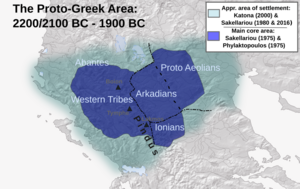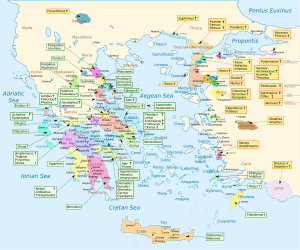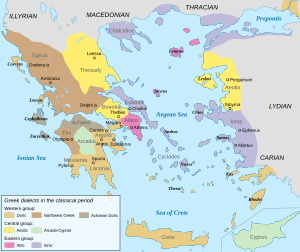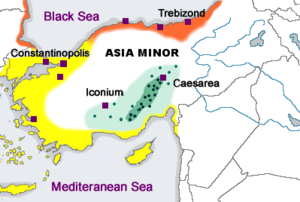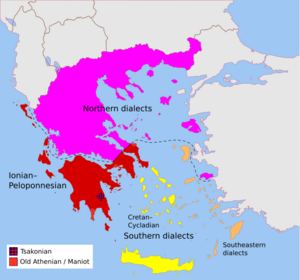History of Greek facts for kids
The Greek language is very old! It's part of a big language family called Indo-European. Greek is the only language left from a smaller group called Hellenic.
Even though it separated from other languages a long time ago (before 2000 BC), we first found written Greek in the Bronze Age. This early form is called Mycenaean Greek.
Later, during the Archaic and Classical times, Greek speakers wrote many texts. They used different types of Greek, all known as Ancient Greek.
In the Hellenistic era, these different types of Greek blended together. This created Koine Greek, which means "common Greek". It became a language used by many people for trade and communication across the eastern Roman Empire.
Koine Greek then changed into Medieval Greek. For a long time, Modern Greek had two main forms. One was informal, called Dimotiki. The other was formal, called Katharevousa. Today, Modern Standard Greek mostly comes from Dimotiki. But it still has some parts from Katharevousa.
Contents
Proto-Greek: The Earliest Form
The Proto-Greek language was the first form of Greek. All later Greek types came from it. Proto-Greek separated from its closest language relatives before 2200-2000 BC. We don't know if the changes that made Greek unique happened in Greece. Or if the Proto-Greek speakers moved into Greece already speaking it.
Mycenaean Greek: The First Written Greek
The first way Greek was ever written was using a system called Linear B. This system used symbols for whole syllables, not single letters. It was used for the old Mycenaean type of Greek. People finally figured out how to read Linear B in 1953.
After the Mycenaean civilization fell apart around 1200 BC, there was a long time (about 500 years) when we don't have any Greek writing. It's like a "dark age" for writing. Later, in classical times, Greek started being written using the Greek alphabet.
Ancient Greek: Many Dialects
In ancient times, Greek had three main types, or dialects. These were Aeolic, Ionic, and Doric. Each dialect was spoken by a different main group of Greeks.
- The Aeolians lived mostly on islands in the Aegean Sea. They also lived on the west coast of Asia Minor.
- The Ionians lived mainly on the west coast of Asia Minor, including Smyrna.
- The Dorians lived mostly in the southern part of Greece, like Sparta and Crete.
Homer's famous stories, the Iliad and the Odyssey, were written in a type of Ionic Greek. They also had some words from other dialects. Because of Homer, Ionic became the main language for literature in ancient Greece. This lasted until Athens became very powerful. Doric Greek was used for Greek poetry and songs.
Attic Greek: The Language of Athens
Attic Greek was a special type of Ionic Greek. It was the language of Athens for many centuries. Most of the old Greek literature we still have today is in Attic Greek. This includes the writings of famous thinkers like Plato and Aristotle.
Koine Greek: The Common Language
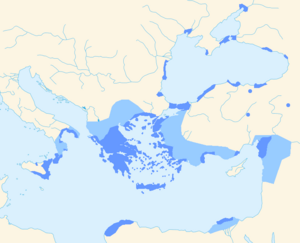
For a long time, Greek had many different dialects. But when Greek culture spread far and wide under Alexander the Great, the Attic dialect became the basis for Koine Greek. "Koine" (Κοινή) means "common."
People in the lands Alexander conquered learned Greek. This helped Greek become a language used all over the world. Greek continued to be important after Alexander's time. This was during the Hellenistic period (323 BC to 31 BC). During this time, the Septuagint was created. This was a Greek translation of the Hebrew Bible.
For many centuries, Greek was the main language in the eastern part of the Roman Empire. The Greek New Testament was also written during Roman times. That's why Koine Greek is sometimes called "New Testament Greek."
Medieval Greek: The Byzantine Era
Medieval Greek is also known as Byzantine Greek. It's the form of the Greek language used during the Middle Ages. This period lasted from about 600 AD until the Ottoman conquest of Constantinople in 1453.
From 620 AD onwards, Greek was the only language used by the government in the Byzantine Empire. This was because of changes made by Emperor Heraclius. Medieval Greek connects the ancient and modern forms of the language. Its literature was still very much like Ancient Greek. But many features of Modern Greek were already starting to appear in how people spoke.
Modern Greek: Today's Language
The "modern" period of the Greek language is often said to start in 1453. This was when the Byzantine Empire fell. However, many features of modern Greek were already present centuries before that.
For most of this period, Greek had two main forms. There were local spoken dialects. And there were older, more formal written forms.
After Greece became an independent country in 1829, a form called Katharevousa (Καθαρεύουσα) was made the official language. Katharevousa means "purified language." This led to a "language war" between two groups. The Dhimotikistés (Δημοτικιστές) supported the common, spoken language (Demotic). The Lóyii (Λόγιοι) or Katharevusyáni (Καθαρευουσιάνοι) supported the "purified dialect." Using Demotic in government was generally not allowed.
After a political change in Greece in 1974, the Demotic dialect was accepted. It became the official language for the Greek government. However, the Katharevousa movement still left some marks on the language.
Today, standard modern Greek is based on Demotic. It is the official language of both Greece and Cyprus. About 12 to 15 million people speak Greek today. Most live in Greece and Cyprus. But there are also Greek communities in many other countries.
See also
 In Spanish: Historia del idioma griego para niños
In Spanish: Historia del idioma griego para niños
- History of the Latin language


